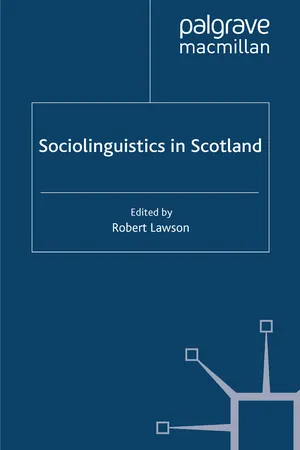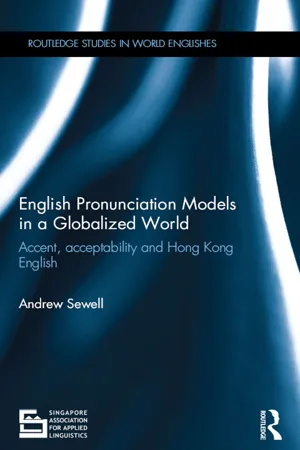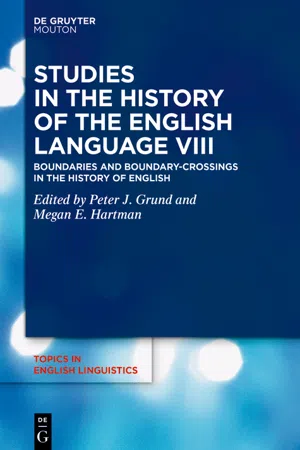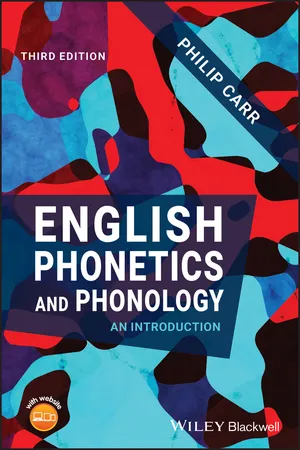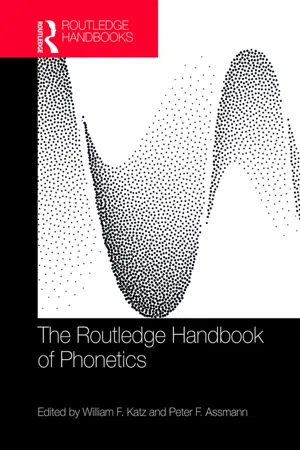Languages & Linguistics
Rhotic Accent
A rhotic accent is a type of accent in which the "r" sound is pronounced in all positions within a word. This is in contrast to non-rhotic accents, where the "r" sound is not pronounced in certain positions, particularly at the end of a syllable. Rhotic accents are found in many varieties of English, including American English and some regional dialects of British English.
Written by Perlego with AI-assistance
9 Key excerpts on "Rhotic Accent"
- eBook - ePub
English with an Accent
Language, Ideology, and Discrimination in the United States
- Rusty Barrett, Jennifer Cramer, Kevin B. McGowan(Authors)
- 2022(Publication Date)
- Routledge(Publisher)
Rhotic sounds fancy, but it is just an adjective meaning R-like. As a noun, it denotes a broad family of sounds that often have very little in common in the way they are pronounced or the physical sounds themselves. The rhotic sounds are grouped together as rhotics simply because they sound to listeners like they should be written down with the letter ‘r’. There are exquisitely detailed descriptions of each of the apparently unrelated sounds that fall into this category, but a general definition isn’t currently possible for the category itself. This is a uniquely difficult category of sounds for linguists to work with because most families of sounds will have some distinctive articulatory or acoustic feature that binds them together in the minds of speakers. Nasal sounds, like the [n], [m], and [ŋ] at the ends of the words sun, sum, and sung share a very clear set of features both as speech gestures and as sounds. The family of sounds called rhotics has no such common feature (Ladefoged & Maddieson 1996). There have been some efforts to improve upon this situation (see, for example, Lindau 1985), but for experts and non-experts alike, the word rhotic just means the sounds that, when written down, are usually written with the letter ‘r’. In most American English dialects today, the letter ‘r’ is used to represent a sound that phoneticians describe as an approximant. Approximants are the most vowel-like of the consonants in both the way they are produced in the mouth and in the way they vary from region to region - eBook - ePub
- R. Lawson, R. Lawson, R. Lawson(Authors)
- 2014(Publication Date)
- Palgrave Macmillan(Publisher)
4
A Socio-Articulatory Study of Scottish Rhoticity*
Eleanor Lawson, James M. Scobbie and Jane Stuart-SmithIntroduction
Increasing attention is being paid in sociolinguistics to how fine phonetic variation is exploited by speakers to construct and index social identity (Hay and Drager 2007). To date, most sociophonetic work on consonants has made use of acoustic analysis to reveal unexpectedly subtle variation which is nonetheless socially indexical (e.g. Docherty and Foulkes 1999). However, some aspects of speech production are not readily recoverable even with a fine-grained acoustic analysis. New articulatory analysis techniques, such as ultrasound tongue imaging (UTI), allow researchers to push the boundaries further, identifying seemingly covert aspects of speech articulation which pattern with indexical factors with remarkable consistency. One such case is postvocalic /r/ variation in Central Scotland.Although Scottish English is usually characterised as a rhotic variety of English, in recent decades sociolinguistic research has identified a weakening of rhoticity among certain socio-economic groups in lowland Central Scotland. Social-indexical patterns of rhoticity in this most populous geographical area of Scotland are reminiscent of those found by Labov in his 1960s New York study (Labov 1966) in that postvocalic /r/ seems to be one of the most consistent markers of socio-economic status. In Labov’s New York study, variants which were not easily identified as either /r/ or Ø were not included in the final analysis, but in Central Scotland, a more gradient picture of rhoticity is emerging. Speakers are still, on the whole, rhotic; it is the degree of strength of rhoticity, rather than presence or absence of postvocalic /r/ that is indicative of a particular socio-economic status. This social stratification of rhoticity in Scottish English seems to be the result of a slow-moving, local sound change, rather than resulting from contact with speakers of non-rhotic varieties of English (see Romaine 1978; Speitel and Johnston 1983). - eBook - ePub
English Accents and Dialects
An Introduction to Social and Regional Varieties of English in the British Isles, Fifth Edition
- Arthur Hughes, Peter Trudgill, Dominic Watt(Authors)
- 2013(Publication Date)
- Routledge(Publisher)
Scottish and Irish accents (like most North American accents) typically do, by contrast, have /ɹ/ in this position. These /ɹ/-pronouncing accents are known as Rhotic Accents (or, especially by Americans, as ‘r-ful’ accents); those which do not permit post-vocalic /ɹ/ are called non-rhotic (or ‘r-less’) accents. Beyond the UK, non-Rhotic Accents can be found in many parts of the world, including Australia, New Zealand, South Africa, West Africa, the southern United States, New York City, parts of New England and the Caribbean. Within England and Wales the position of post-vocalic /ɹ/ in regional accents is quite complex, but we can generalise and say that /ɹ/-ful pronunciations are being lost – post-vocalic /ɹ/, in other words, is dying out – and that one is more likely to hear post-vocalic /ɹ/ in the speech of older, working-class rural speakers than from younger middle-class urban speakers. It is also receding in urban Scotland, where the speech of young working-class people in Glasgow and Edinburgh is derhotacising. Map 4.2 shows those areas where post-vocalic /ɹ/ still occurs in the British Isles. Map 4.2 Post-vocalic /ɹ/ in the UK and Ireland This difference between English accents is due to a linguistic change involving the loss of post-vocalic /ɹ/, which began some centuries ago in the south-east of England, and has since spread to other regions. This loss of /ɹ/ has also had a further consequence (see also page 47). The consonant /ɹ/ was lost in these accents before a following consonant, as in cart, but was retained before a following vowel, as in carry. This meant that whether or not the /ɹ/ was pronounced in words like car depended on whether it was followed by a word beginning with a vowel or a word beginning with a consonant (or by a pause). Thus we have car alarm with /ɹ/ /ˈkɑːɹəˈlɑːm/ but car keys without /ɹ/ /ˈkɑːˈkiːz/ The /ɹ/ in the pronunciation of car alarm is known as ‘linking /ɹ/’, as we saw in the previous chapter - eBook - ePub
English Pronunciation Models in a Globalized World
Accent, Acceptability and Hong Kong English
- Andrew Sewell(Author)
- 2016(Publication Date)
- Routledge(Publisher)
Trudgill (ibid.) also points out that most Standard English speakers do not have ‘broad’ local accents with many regional features. Regardless of what the standard accent is perceived to be in any particular locale, discussion of deviations from it also reveals the influence of a generalized standard language ideology. It is worth noting that such discussion tends to rely on written rather than spoken language for its points of reference. Much of the terminology of accent features in both specialized and public discourse, such as /h/- dropping, consonant cluster reduction, and so on, suggests that familiarity with written language affects our perception of what we hear and how we categorize it. I will return to the question of ‘standardness’ and its relationship with written language in Chapters 6 and 7. It is worth noting here that accent and pronunciation play an interesting role in creating indexical positions such as ‘standardness’. Eckert (2008: 468) notes the general way in which hyperarticulated pronunciation – ‘careful’ pronunciation, bearing a close resemblance to written or ‘dictionary’ forms – has indexical associations with ‘carefulness’ as a character attribute, while hypoarticulation has connotations of laziness. This ‘leakage’ between the physical, embodied qualities of pronunciation and their indexical meanings is also noted by Zhang (2005, 2008) in studies of the Beijing accent of Mandarin Chinese. The accent feature known as rhotacization lends an ‘r’-like sound to many word endings, and this helps to create an aural impression of ‘smoothness’; according to one interviewee ‘the sound flows smoothly, free of roughness and harshness’ (Zhang 2008: 209). The interesting point is that this aural impression has gained indexical associations with a ‘smooth’ Beijing persona (Zhang 2008: 211) - eBook - ePub
- William F. Katz(Author)
- 2013(Publication Date)
- For Dummies(Publisher)
lɑɪ̃n ]). They also have many vocabulary and syntactic differences.If all else fails, a phonetician can always fall back on the /æ /-split in certain loanwords that have [ɑ ] in GAE. To see if somebody is from Canada, ask him or her how to pronounce “taco,” “pasta,” or “llama.” If he or she has an /æ / in these words, the person is probably Canadian.Transcribing English of the United Kingdom and IrelandDescribing the English dialects of the United Kingdom and Ireland is a tricky business. In fact, there are enough ways of talking in the British Isles and Ireland to keep an army of phoneticians employed for a lifetime, so just remember that there is no one English/Irish/Welsh/Scottish accent. This section provides an overview to some well-known regional dialects in the area.England: Looking closer at EstuaryEstuary English refers to a new accent (or set of accents) forming among people living around the River Thames in London. However, before exploring this fine-grained English accent, let me start with some basics.England is a small and foggy country, crammed with amazing accents. At the most basic level, you can define broad regions based on some sound properties. Here are three properties that some dialectologists begin with:Rhoticity: This characteristic focuses on whether an “r” is present or not after a vowel, such as in “car” and “card.” Large areas of the north aren’t rhotic, while parts of the south and southwest keep r-colored vowels.The shift from / ʌ / to / ʊ /: In the south, /ʌ / remains the same, while in the north it shifts to /ʊ /, such that “putt” and “put” are pronounced [pʰʌt ] and [pʰʊt ] in the south but [ʊ ] in the north.The shift from / æ / to / ɑ /: This division has an identical boundary to the preceding shift. For example, consider the word “bath” [bɑθ - eBook - ePub
Corpus Linguistics and the Analysis of Sociolinguistic Change
Language Variety and Ideology in Advertising
- Joan O'Sullivan(Author)
- 2019(Publication Date)
- Routledge(Publisher)
Chapter 6 , we can see that from 1977 to 2017, the percentage of Comment components which display IrE rhotic pronunciation increases ten-fold from 9% to 90%. The use of Rhotic Accent in the Action components increases from 35% to 92% in the same time period. As discussed above, the decline of the non-rhotic Comment voice and the prevalence of rhotic IrE pronunciation in both components of the ad in the more recent subcorpora calls for an analysis of the sub-varieties of this rhotic IrE accent.Table 7.1 displays the tags used to code ‘local’ and ‘non-local’ accent sub-varieties in IrE, as outlined in Chapter 5 .Table 7.1 Tags for Irish English sub-varietiesIrE sub-varieties: Tags Non-local Local <rhSrS> rhotic Supraregional Southern <rhReg> rhotic Regional <rhModD> rhotic Moderate Dublin <rhLD> rhotic Local Dublin <rhAdvD> rhotic Advanced Dublin As Chapter 6 has shown, we can search the relevant subcorpora on the particular accent variety tag to display concordance lines for the specific sub-variety; the tag <rhAdvD>, for example, indicates that the accent is IrE (as demonstrated through the use of rhotic /r/), while the accent sub-variety of IrE is that of the relatively new form, AdvD accent (as described in Chapter 2 ). Figure 7.1 shows a sample of the results of a search of the 2017 Comment subcorpus, using this tag.Figure 7.1 Sample concordance lines for <rhAdvD (Advanced Dublin English) (2017 Comment subcorpus)(WordSmith Tools version 6)As we have seen, searching with an open bracket (<rhAdvD) allows us to establish whether the searched variety combines with another variety within the ad component. Concordance Line 1 in Figure 7.1 , for example, shows that in the Comment component for this ad, both an AdvD and a regional IrE accent were used by different speakers. As described in Chapter 5 - eBook - ePub
Studies in the History of the English Language VIII
Boundaries and Boundary-Crossings in the History of English
- Peter Grund, Megan Hartman, Peter Grund, Megan Hartman(Authors)
- 2020(Publication Date)
- De Gruyter Mouton(Publisher)
Section 3: Language and language variety boundaries8 Germanic /r/ as an isogloss, rhotacism, and the West Germanic gemination
Anatoly LibermanDepartment of German, Nordic, Slavic, and Dutch, University of Minnesota , Minneapolis , MN , USA1 The isolated phoneme /r/ as an isogloss and boundary maker
It is the purpose of this paper to trace the history of the phoneme /r/ in Germanic and show how it acquired its present-day realization in British and American English. Many events will have to be discussed along the way: rhotacism, which resulted in a clash between old (inherited) /r/ and new /r/ (from */z/); the enigmatic resistance of /r/ of either origin to lengthening; and its final integration into the system of resonants. Solutions to three riddles will be offered, namely, what triggered rhotacism, what caused West Germanic lengthening, and why /r/ remained short before /j/. It will also be shown how a phonemic approach to sound change may provide answers where attention to purely phonetic factors fails to do so.To an outsider, no feature in the phonetic makeup of a modern Indo-European language defines its auditory character more strongly than the articulation of [r]. From the phonological point of view it may not be too important whether one has mastered the Parisian uvular [r], the Russian trill, or the British English “liquid” [r], as opposed to American [r], but the resulting sound colors the speaker’s accent in a decisive way; it is a classic shibboleth. Although, in theory, phonology studies only distinctive features and leaves realization to phonetics, the production and distribution of /r/ are among the most important and controversial questions of Indo-European historical phonology. One notes that Armenian and Classical Greek lacked initial /r/ (see the discussion of this evergreen question in Lehmann 1951 - eBook - ePub
English Phonetics and Phonology
An Introduction
- Philip Carr(Author)
- 2019(Publication Date)
- Wiley-Blackwell(Publisher)
12 Variation in English Accents12.1 Introduction
In this chapter, we will consider some general aspects of accent variation. In Chapter 13 , a brief overview is given of several accents of English: London English, Tyneside English, Standard Scottish English (SSE), New York City English, Texan English, Australian English and Indian English, followed by an outline of the sorts of phenomena which give rise to divergence of accents over time.Three of the accents we have referred to in this book (GA, RP and SSE) are viewed socially as ‘standard’ accents. The notion ‘standard’ is a social one: no linguist would claim that there is any coherent notion of inherent phonetic or phonological superiority, since such a notion simply does not make any phonetic or phonological sense. There can be no doubt that many people judge some accents to be superior to others, or take some accents to be standard accents and others to be non‐standard accents. But those judgements are founded on non‐linguistic factors, to do with social attitudes in the societies in question. From a strictly linguistic point of view, such judgements are, quite clearly, entirely arbitrary. For example, RP, the standard accent in England, is non‐rhotic, and the non‐rhoticity of RP is therefore judged by some (perhaps many) English people to be more prestigious than the Rhotic Accents found in many of the Western parts of England. But the standard accents SSE and GA are rhotic, and in the United States, it is the Rhotic Accents which are often judged to be more prestigious than the non‐rhotic American accents (the judgement cannot arise in Scotland, where all native accents are rhotic).Clearly, it is social attitudes which determine such judgements about accents, rather than the phonetic and phonological properties of the accents themselves. It is common to find social judgements to the effect that some accents are ‘uglier’ or ‘harsher’ than others. These judgements too are entirely arbitrary as far as phonetics and phonology are concerned. For instance, if the word say, pronounced as [saɪ] in London English, is judged ‘ugly’ by an RP speaker, then the RP speaker’s own pronunciation of the word sigh - eBook - ePub
- William F. Katz, Peter F. Assmann, William F. Katz, Peter F. Assmann(Authors)
- 2019(Publication Date)
- Routledge(Publisher)
The second rhotic is an approximant or glide (the terms are often used interchangeably), and like the trill, it involves a sharp drop in energy from the adjacent vowels (note however that although this is typically the case in Arrernte, a rhotic glide does not always involve a clear drop in energy in all languages). The rhotic glide in this particular example has a very strong spectral prominence centered at about 1750 Hz. This is most likely the combined spectral prominence of F 2 and F 3 together. The other formants are comparatively much weaker for the glide in this particular spectrogram. Notably, however, both the trill and the glide induce a low F 3 in the adjacent vowels (perhaps a little less obvious in the case of the preceding vowel for the trill, but noticeable in all three other adjacent vowels). Figure 10.4 Waveform and spectrogram of Arrernte speaker Janet Turner (female) producing the minimal pair arreme (“louse”) followed by areme (“see”). The segment “rr” denotes the alveolar /r/ and “r” denotes the retroflex glide /ɻ/. The frequency range of the spectrogram is 0–5 kHz, and the duration values along the y-axis are given in seconds. In this particular example I have used the symbol for a retroflex glide /ɻ/, but some authors use the symbol for an alveolar glide /ɹ/ to denote the rhotic consonant in languages such as English. The exact articulatory differences between these two sounds are perhaps not terribly clear, but in general the retroflex symbol tends to be used for slightly “darker” sounds than the alveolar rhotic symbol (“dark” being a subjective measure dependent on the hearer’s language background, but in general perhaps referring to just how low the F 2 + F 3 spectral prominence might be). In principle, the point of constriction for a “retroflex” rhotic glide should be a little further back than for an alveolar glide
Index pages curate the most relevant extracts from our library of academic textbooks. They’ve been created using an in-house natural language model (NLM), each adding context and meaning to key research topics.
Explore more topic indexes
Explore more topic indexes
1 of 6
Explore more topic indexes
1 of 4

